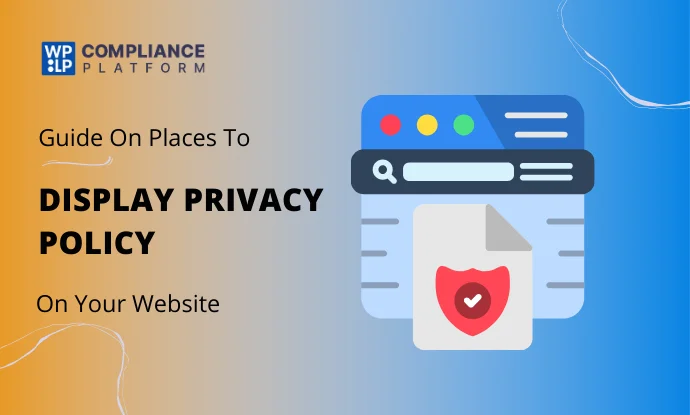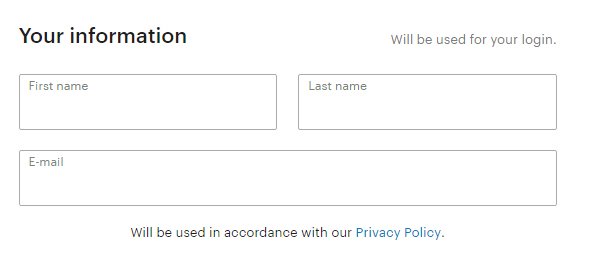Top Places To Display Privacy Policy On Your Website

Where Should You Display Your Privacy Policy for Maximum Impact?
Creating a privacy policy with a trusted privacy policy generator is a smart move, but its placement on your website is just as important as its content. A strategically placed privacy policy ensures compliance with legal standards like GDPR or CCPA and builds trust with your audience by showcasing your commitment to transparency.
But where exactly should you display it to maximize visibility and user accessibility? Visitors expect to find this critical information quickly, especially when sharing details. It could raise concerns and diminish trust if it’s hidden or inaccessible.
This article will explore the best places to display your privacy policy. From the footer of your website to key areas like sign-up forms or checkout pages, we’ll guide you on ensuring your privacy policy is accessible, user-friendly, and aligned with industry best practices.
Reasons to Make Privacy Policy Accessible:
1. It is important
A privacy policy is one of the essential information pieces that you can publish on your website. You’d have to ensure that your users don’t face any trouble when accessing it and should also glance at it before purchasing any of your product services.
2. Builds Trust
Placing this policy in a prominent website area and making it easy for visitors to read increases trust and credibility among users. They’ll be rest assured that you aren’t hiding anything from them, and their decision will be completely unbiased.
3. Keeps the Team Observant
Putting the privacy policy front for the public reminds you and your entire team to adhere to the rules and regulations mentioned in the policy. It will encourage everyone on the panel to stand true to their standards and value.
4. Will be Easily Read
Let’s get the cat out of the bag. Most users find reading policies mentioned on the website tedious and time-consuming. They’d skip going through every word to understand how your company operates. Hence, the chances of visitors reading and understanding the policy increase when you publish it in a prominent place while following the legal practices to make it concise and straightforward.
Privacy Policies Across the World
All across the world, a myriad of legal regulations are designed to protect every internet user’s privacy. Therefore, the necessity of a well-written privacy policy cannot be ignored to ensure online commerce safety.
One common condition is that these policies should be accessible to users with ease. For your website, you can use premium WordPress plugins and come up with an informed policy for your visitors.
Some of the primary policies are:
- The General Data Protection Regulation, or GDPR, was developed to safeguard the privacy rights of internet users of the 28 European Union countries.
- CalOPPA, abbreviated for the California Online Privacy Protection Act, was designed in California to protect the residents’ privacy policy.
- Personal Information Protection and Electronic Documents Act (PIPEDA) is a law developed by Canada to protect local citizens whenever they deal with private businesses, specifically on the Internet. This act comprises particular stipulations in terms of privacy policy language. It states that the language should be simple enough for mentally impaired children to understand.
Keeping these laws in mind, today, it’s almost impossible to advertise your brand virtually to anyone without having a sturdy privacy policy.
Where Can You Place Privacy Policy on the Website?
Having a privacy policy is essential for any website. It helps establish trust, ensures compliance with legal requirements, and demonstrates your commitment to safeguarding user data.
However, crafting your privacy policy with a generator is only half the battle; strategically placing it on your website is equally critical.
Below, we explore some of the top locations to display your privacy policy to ensure it’s visible, accessible, and user-friendly.
1. Footer Links

One of the most common and effective places to display your privacy policy is in the footer of your website. The footer is accessible from every page, making it easy for users to locate the privacy policy regardless of where they are on your site. By including it as a link labeled “Privacy Policy,” you ensure consistency and visibility.
Why this works:
- User Expectation: Visitors often look for important links, such as privacy policies, terms of service, or contact information, in the footer.
- Legal Compliance: Regulatory frameworks like GDPR and CCPA often require that privacy policies be easily accessible, and the footer fulfills this criterion.
To enhance visibility, pair your privacy policy link with related links, such as “Terms of Service” or “Cookie Policy.” Using a privacy policy generator like WP Legal pages, you can ensure the document is professionally formatted and meets legal standards, making it easier to integrate into your site’s footer.
This image mentioned above is from the club.wepeka.com website. Their privacy policy URL can be found at the end of every page. While it might not always appear the same, you’ll always find it there.
2. Sign-up Forms

Sign-up forms are critical touchpoints where users share their personal information, such as names, email addresses, or phone numbers. Displaying a link to your privacy policy near or within your sign-up form reassures users that their data will be handled responsibly.
Best practices for this placement:
- Clear Disclosure: Add a short statement like, “By signing up, you agree to our [Privacy Policy],” with the link embedded in the text.
- Ease of Access: Ensure the link is clickable and open the privacy policy in a new tab so users can read it without losing their progress.
- Transparency: Highlight specific data usage points, such as “We’ll never share your email with third parties.”
Incorporating the privacy policy at this stage builds trust and aligns with legal requirements that demand explicit consent for collecting personal data.
The New Yorker has placed a link to its privacy policy in the registration form and a declaration that the information will be used according to the policy.
3. Checkout Pages

Checkout pages are another vital area where your privacy policy should be prominently displayed. When users are about to make a purchase and share sensitive information like credit card details or addresses, they need reassurance about the security of their data.
Why it’s important:
- Boosts Confidence: Users are more likely to complete their purchase if they know their personal and payment details are protected.
- Legal Compliance: Many jurisdictions require businesses to inform users how their data will be processed during transactions.
Tips for integrating the privacy policy:
- Include a statement like, “Your data is secure and handled according to our [Privacy Policy]” near the payment fields.
- Make the privacy policy link easy to spot and ensure it’s functional on desktop and mobile devices.
- Use simple language to explain how you handle data security and what users can expect after completing their transactions.
Placing your privacy policy on the checkout page can reduce cart abandonment rates and enhance customer trust.
4. Landing Page Banner
For websites running specific campaigns or promotions, a landing page banner is a great place to showcase your privacy policy. These banners are usually located at the top or bottom of the page and are highly visible to visitors.
How to use it effectively:
- Cookie Notices: Pair your privacy policy with a cookie consent banner. For example, “This website uses cookies to enhance your experience. By using our site, you agree to our [Privacy Policy].”
- Promotional Transparency: If the landing page involves collecting user data for a giveaway or subscription, include a link to the privacy policy explaining how the data will be used.
- Highlight Compliance: Use the banner to emphasize your commitment to GDPR, CCPA, or other relevant privacy regulations.
This approach is particularly effective for first-time visitors who might be skeptical about sharing their information. By placing the privacy policy front and center, you immediately build credibility and demonstrate transparency.
Additional Tips for Displaying Your Privacy Policy
- Make It Mobile-Friendly: Ensure your privacy policy is easily accessible on mobile devices. Use responsive design to ensure the text is readable and links are functional on smaller screens.
- Use Clear Language: Avoid legal jargon and write your privacy policy in simple, user-friendly language. This makes it easier for visitors to understand and fosters trust.
- Update Regularly: Keep your privacy policy up to date with the latest legal requirements and changes in your data handling practices. A privacy policy generator can help streamline this process.
- Test Accessibility: Check all links to your privacy policy to ensure they work correctly. Broken links can frustrate users and make your website appear unprofessional.
Strategically placing your privacy policy on your website is crucial for compliance, transparency, and user trust. Whether in the footer, sign-up forms, checkout pages, or a landing page banner, each location makes your privacy policy easily accessible.
What to Include in the Privacy Policy?
When creating a privacy policy, precise information may depend on the prevailing policies or laws. However, generally, privacy policy laws may demand you to inform your visitors about:
- Your business name, contact information, and location
- You’re collecting information, including email address, name, IP address, etc.
- Methods you’re using to collect the information and what you’re going to do with it
- Practices you’re using to keep their data safe
- How visitors can opt-out from sharing their information and the repercussions that they’d have to face
- Whether you’re using any third-party services to collect, process, or keep their data
Conclusion
Both law and business practices demand that your privacy policy be accessible to visitors before and after interacting with your website. Hence, it’s important to create one on the website. Even if you aren’t collecting or using customers’ data, you can still post a policy to be on the safe side.
Make sure that you’re clear and on-point with the policy. And, be wary of the placement as well to prevent legal issues in the future. If you wish to know more, you can research your country’s laws and take the required action accordingly.To simplify this process, consider using the WP Legal Pages plugin.
This tool helps you generate professional privacy policies, terms of service, and other essential legal pages tailored to your business needs. With its user-friendly interface and customizable templates, WP Legal Pages ensures your website effortlessly complies with global regulations like GDPR and CCPA. Add it to your toolkit today to enhance trust and ensure compliance.
If you found this article helpful, feel free to check out our other published articles for further insights and information.
